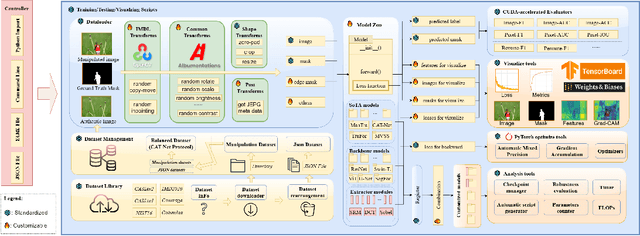Bingkui Tong
M^3:Manipulation Mask Manufacturer for Arbitrary-Scale Super-Resolution Mask
Jul 04, 2024Abstract:In the field of image manipulation localization (IML), the small quantity and poor quality of existing datasets have always been major issues. A dataset containing various types of manipulations will greatly help improve the accuracy of IML models. Images on the internet (such as those on Baidu Tieba's PS Bar) are manipulated using various techniques, and creating a dataset from these images will significantly enrich the types of manipulations in our data. However, images on the internet suffer from resolution and clarity issues, and the masks obtained by simply subtracting the manipulated image from the original contain various noises. These noises are difficult to remove, rendering the masks unusable for IML models. Inspired by the field of change detection, we treat the original and manipulated images as changes over time for the same image and view the data generation task as a change detection task. However, due to clarity issues between images, conventional change detection models perform poorly. Therefore, we introduced a super-resolution module and proposed the Manipulation Mask Manufacturer (MMM) framework. It enhances the resolution of both the original and tampered images, thereby improving image details for better comparison. Simultaneously, the framework converts the original and tampered images into feature embeddings and concatenates them, effectively modeling the context. Additionally, we created the Manipulation Mask Manufacturer Dataset (MMMD), a dataset that covers a wide range of manipulation techniques. We aim to contribute to the fields of image forensics and manipulation detection by providing more realistic manipulation data through MMM and MMMD. Detailed information about MMMD and the download link can be found at: the code and datasets will be made available.
Beyond Visual Appearances: Privacy-sensitive Objects Identification via Hybrid Graph Reasoning
Jun 18, 2024Abstract:The Privacy-sensitive Object Identification (POI) task allocates bounding boxes for privacy-sensitive objects in a scene. The key to POI is settling an object's privacy class (privacy-sensitive or non-privacy-sensitive). In contrast to conventional object classes which are determined by the visual appearance of an object, one object's privacy class is derived from the scene contexts and is subject to various implicit factors beyond its visual appearance. That is, visually similar objects may be totally opposite in their privacy classes. To explicitly derive the objects' privacy class from the scene contexts, in this paper, we interpret the POI task as a visual reasoning task aimed at the privacy of each object in the scene. Following this interpretation, we propose the PrivacyGuard framework for POI. PrivacyGuard contains three stages. i) Structuring: an unstructured image is first converted into a structured, heterogeneous scene graph that embeds rich scene contexts. ii) Data Augmentation: a contextual perturbation oversampling strategy is proposed to create slightly perturbed privacy-sensitive objects in a scene graph, thereby balancing the skewed distribution of privacy classes. iii) Hybrid Graph Generation & Reasoning: the balanced, heterogeneous scene graph is then transformed into a hybrid graph by endowing it with extra "node-node" and "edge-edge" homogeneous paths. These homogeneous paths allow direct message passing between nodes or edges, thereby accelerating reasoning and facilitating the capturing of subtle context changes. Based on this hybrid graph... **For the full abstract, see the original paper.**
IMDL-BenCo: A Comprehensive Benchmark and Codebase for Image Manipulation Detection & Localization
Jun 15, 2024



Abstract:A comprehensive benchmark is yet to be established in the Image Manipulation Detection \& Localization (IMDL) field. The absence of such a benchmark leads to insufficient and misleading model evaluations, severely undermining the development of this field. However, the scarcity of open-sourced baseline models and inconsistent training and evaluation protocols make conducting rigorous experiments and faithful comparisons among IMDL models challenging. To address these challenges, we introduce IMDL-BenCo, the first comprehensive IMDL benchmark and modular codebase. IMDL-BenCo:~\textbf{i)} decomposes the IMDL framework into standardized, reusable components and revises the model construction pipeline, improving coding efficiency and customization flexibility;~\textbf{ii)} fully implements or incorporates training code for state-of-the-art models to establish a comprehensive IMDL benchmark; and~\textbf{iii)} conducts deep analysis based on the established benchmark and codebase, offering new insights into IMDL model architecture, dataset characteristics, and evaluation standards. Specifically, IMDL-BenCo includes common processing algorithms, 8 state-of-the-art IMDL models (1 of which are reproduced from scratch), 2 sets of standard training and evaluation protocols, 15 GPU-accelerated evaluation metrics, and 3 kinds of robustness evaluation. This benchmark and codebase represent a significant leap forward in calibrating the current progress in the IMDL field and inspiring future breakthroughs. Code is available at: https://github.com/scu-zjz/IMDLBenCo
SHAN: Object-Level Privacy Detection via Inference on Scene Heterogeneous Graph
Mar 14, 2024Abstract:With the rise of social platforms, protecting privacy has become an important issue. Privacy object detection aims to accurately locate private objects in images. It is the foundation of safeguarding individuals' privacy rights and ensuring responsible data handling practices in the digital age. Since privacy of object is not shift-invariant, the essence of the privacy object detection task is inferring object privacy based on scene information. However, privacy object detection has long been studied as a subproblem of common object detection tasks. Therefore, existing methods suffer from serious deficiencies in accuracy, generalization, and interpretability. Moreover, creating large-scale privacy datasets is difficult due to legal constraints and existing privacy datasets lack label granularity. The granularity of existing privacy detection methods remains limited to the image level. To address the above two issues, we introduce two benchmark datasets for object-level privacy detection and propose SHAN, Scene Heterogeneous graph Attention Network, a model constructs a scene heterogeneous graph from an image and utilizes self-attention mechanisms for scene inference to obtain object privacy. Through experiments, we demonstrated that SHAN performs excellently in privacy object detection tasks, with all metrics surpassing those of the baseline model.
 Add to Chrome
Add to Chrome Add to Firefox
Add to Firefox Add to Edge
Add to Edge